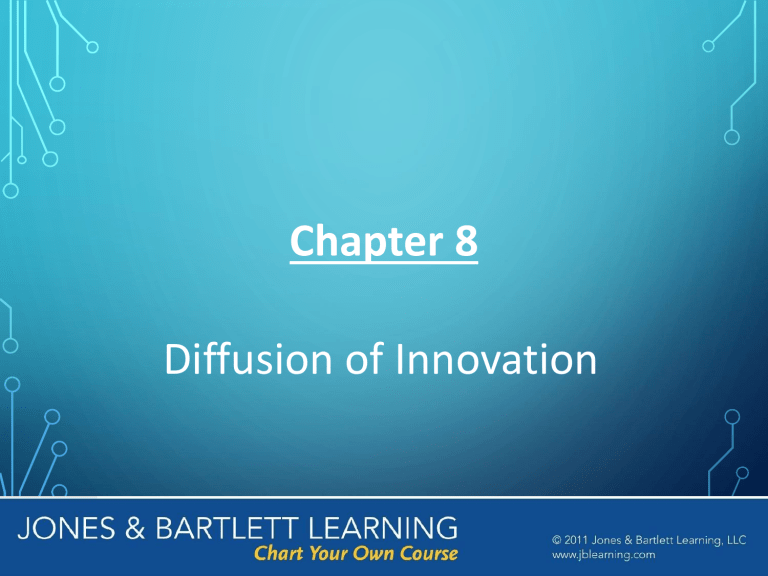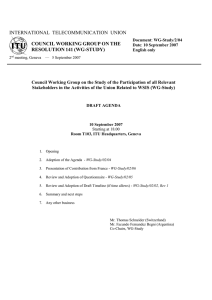
Chapter 8 Diffusion of Innovation IN THE BEGINNING… • Diffusion of Innovation is a communication theory with its roots in rural sociology • It was used to determine the effectiveness of different methods of informing farmers about new (innovative) farming practices. • Research done in the 1940s on innovative hybrid corn seed (a new farming practice) revealed that farmers were not using it, even though it produced more corn and would raise their profits. IN THE BEGINNING… • The explanation for the farmers’ slow adoption of the new seed was that the spread and adoption of an innovation is a social process that takes time. • Further research identified four main aspects of diffusion: • Innovation-decision process • Role and source of the communication channel • Adoption rate • Characteristics of people who adopt an innovation at the various rates CONCEPT • Theory Essence Sentence • Behavior changes as innovations are adopted. CONSTRUCTS • Innovation (new idea, product) • Channels through which it is communicated • Time (innovation-decision process and adoption curve) • The social system • Diffusion is the process by which this takes place THE INNOVATION • An innovation is something new or novel • A device • A practice • An idea • A product • Brainstorm some innovations relative to the field of health THE INNOVATION • Characteristics of an innovation that increases the likelihood of adoption include: • Having an advantage over what is already available • Compatibility with social norms and values • Trial on a limited basis • Ease of use • Having observable results THE INNOVATION – RELATIVE ADVANTAGE • Relative advantage: Is it better than what is already available? • Greater chance of adoption if it is better than what is already available or fills a void • Female condom • When introduced it had a decided advantage over what was available because no other product like it existed • “Candy” calcium supplements • Changing from a large pill to a smaller candy-like chewable THE INNOVATION - COMPATIBILITY • Compatibility: Is it compatible with social norms and values • Innovation needs to mesh well with culture, social environment • Hand sanitizers introduced in the 80s. At the time not considered socially acceptable therefore use was not widespread • • Induced the feeling that the establishment was “dirty” Then, over time society became more germ conscious and adoption increased THE INNOVATION - TRIALABILITY • Trialability: can innovation be used on a trial basis? • If individuals can use innovation without making a huge commitment in terms of money, time or effort = increased chance of adoption • Pharma giving doctors free medication samples • Free samples promote physician adoption of medication as well as patient adoption THE INNOVATION - COMPLEXITY • Complexity: Is it easy to use? • The more complex it is to understand and use the less likely it is to be adopted or tried • Female condoms are not easy to use the first time and this can inhibit future use • Nicotine patch • Simple to use and apply = increased rate of adoption THE INNOVATION - OBSERVABILITY • Observability: Does it produce visible results? • If results of using the innovation can be seen by others it is more likely to be adopted • Think about the rate of adoption of breast augmentation, tattoos and body piercing = Noticeable Results! • Chiropractic & acupuncture care are different way to treat illness • First seen with skepticism • Now seen as acceptable treatment options APPLICATION OF CHARACTERISTICS OF INNOVATION: SAFETY HELMET Relative advantage Rider believes a helmet is better protection against the pavement than his bare head, and that his head is more important than looking cool, he is more likely to begin wearing one Compatibility If nobody in the biker's circle of friends thinks the new helmet is a good idea, he is less likely to wear one. Complexity If the design of the helmet does not make its protective features clear immediately, if it is hard to wear, or if it is hard to put on, our biker is less likely to wear it. Trialability If the motorcycle rider can try and return a helmet within 30 days for a full refund, he will be more likely to wear it. Observability If the biker's friends begin talking positively about the protective features of helmets, he is more likely to try one. Summary: Innovations perceived by individuals as having greater relative advantage, compatibility, trialability, observability, and less complexity will be adopted more rapidly than other innovations COMMUNICATION CHANNELS • The communication channel is how an innovation is diffused or spread through a society. • It is a social process • Most rapid and effective means of diffusion is through mass media • Internet, television, newspapers, radio • Interpersonal communications between those sharing similar traits • Beliefs, education level, SES, gender TIME & INNOVATION-DECISION PROCESS • It takes time for a decision to be made to adopt an innovation • Steps in the decision process: • knowledge • persuasion • decision • implementation • confirmation KNOWLEDGE • Before people can think about adopting something new, they have to know it exists • How is it made aware to the public? • Magazines, tv, internet, direct mail? • Disclosure by well-known and trusted public figures? PERSUASION • People develop an attitude toward the innovation once they have knowledge of it. • Positive or negative attitude • Go through a process where by they mentally “try it on” to see if they like the idea or it or not • What is their perception after this process? • Sometimes opinion leaders are persuaded first to gain access to the larger portion of the target DECISION • The decision to try an innovation depends on: • Knowledge of the innovation • Attitude toward innovation • Engage in activities that result in decision to adopt or reject • Knowledge + positive attitude usually leads to trial, but not always • Trying the candy calcium supplement IMPLEMENTATION • Implementation occurs when the innovation is tried • Results in one of the following: • adoption • rejection • or re-invention of the innovation • If the trial implementation results are: • Positive…. the innovation is adopted. • Negative… the innovation is rejected. • Mixed…… the innovation is modified. CONFIRMATION • Sometimes the innovation-decision process is: • Completed • Rejected • When decision to adopt is made we need reinforcement • Via others to confirm that the decision to adopt is a good one = Ultimately adopting • If receive conflicting messages may reject TIME - ADOPTION RATE • People tend to adopt innovations at a reasonably predictable rate depending on certain characteristics. TIME - ADOPTION RATE • The following five categories reflect characteristics and the amount of time it takes for innovation adoption. • Innovators • Early adopters • Early majority • Late majority • Laggards CHARACTERISTICS OF INNOVATORS • Innovators tend to be: • Risk takers • Tech savvy • Independent • Change oriented • They try everything as soon as possible CHARACTERISTICS OF EARLY ADOPTERS • Early Adopters tend to be: • Community opinion leaders • Well respected • Role models • Highly educated with high SES • They have a complex network of friends and colleagues and are very influential people CHARACTERISTICS OF THE EARLY MAJORITY • The Early Majority tend to: • be greatly influenced by opinion leaders and the mass media • adopt things over time • Given the sheer number of people this represents, when they begin to adopt an innovation, it becomes mainstream CHARACTERISTICS OF THE LATE MAJORITY • The Late Majority tend to: • Question change • Have more modest financial resources • Wait until an innovation is an established norm or for it to become a social or economic necessity. • Greatly influenced by their peers. CHARACTERISTICS OF LAGGARDS • Laggards tend to be: • Conservative and traditional • Less educated with lower SES • Suspicious of innovation • Adverse to risk taking • Geographically mobile and detached from the social environment • They wait until very late, even when it’s obvious the innovation is advantageous SOCIAL SYSTEM • A social system can be individuals, an informal or formal group of people, or organizations that are interrelated and engaged in solving a joint problem to accomplish a goal. • Diffusion takes place through these social systems CLASS ACTIVITY • Read the explanation of fecal occult blood testing on pages 216-217 in your text. • With this background and using the characteristics of an innovation, what would an innovative method of testing for fecal occult blood look like? THEORY IN ACTION • Read the following article on page 218 in your text: • Harden E, Moore A, & Melvin C. (2011). Exploring perceptions of colorectal cancer and fecal immunochemical testing among African Americans in a North Carolina community. Preventing Chronic Disease 2011;8(6):A134. http://www.cdc.gov/pcd/issues/2011/nov/10_0 234.htm. CHAPTER ACTIVITY QUESTIONS 1. How does FIT differ from FOBT in relation to the characteristics of an innovation? Relative advantage: FIT preferred over FOBT because no food restrictions Compatibility: Perceive FIT and FOBT as “gross”. Storage of FIT is difficult Complexity: Multi-step instructions of FIT are challenging, difficult for low literacy Trialability: Some thought experimentation/use of FOBT was easy, others thought more difficult. Observability: Discussed how do not hear about CRC screenings compared to other types of screenings. Fear of taking necessary steps CHAPTER ACTIVITY QUESTIONS 2. Were these characteristics among those that your group identified? Answers vary 3. What suggestions were given to increase the likelihood of FIT adoption? Complexity: Clearer instructions and written in large type. Addition of illustrations. Trialability: Hands-on practice (also increases) Compatibility: Adding a storage device to secure samples Observability: Mass media campaigns to increase visibility CHAPTER ACTIVITY QUESTIONS 4. Other than the characteristics of the innovation, what other factors were identified as being an impediment to increasing colon cancer screening? Provider Recommendation: Doctors are an important information source Healthcare Cost and Access: Affordable screening and follow-up



